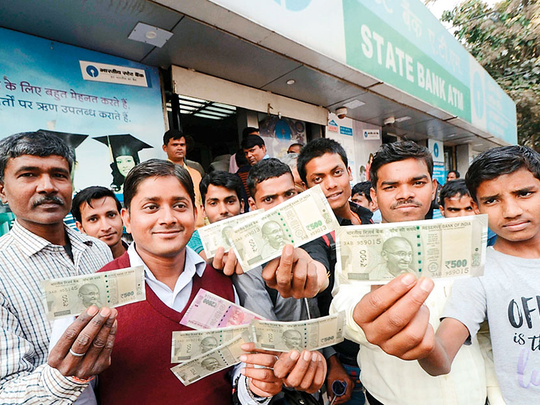
Dubai: Demonetisation has had a profound impact on the way Indians save.
Traditionally Indians used to save in real estate and gold, away from the tickers of green and red of the trading screen. However, with the increased restrictions on real estate and gold, small savers are preferring the mutual fund route — especially through a monthly plan.
The money that is coming in from the mutual fund route dwarfs foreign flows by a huge margin. Mutual funds, in which retail investors save their money, were net investments in October, pulling in Rs99 billion (Dh5.61 billion) of investments, compared to a paltry Rs19 billion invested by foreigners in the same month.
“We are seeing a large structural flow from domestic investors into Indian equities, with domestic mutual funds net buying an average of $1.5 billion [Dh5.5 billion] per month over last 12 months,” said Navneet Munot, executive director and chief investment officer of SBI Funds Management.
Mutual funds have been net buyers in all of the last 12 months running up to October 2017, while foreign institutional investors were net sellers in the last six out of 12 months.
Sukumar Rajah, managing director and chief investment officer for Asian equity and local asset management at Franklin Templeton Investments, feel this trend will consolidate over the short term.
“People are under-invested in equities. EM savings are very high, and [much] less has come into equities, and that is changing significantly, and more so in case of India,” Rajah told Gulf News in August. “The type of money that is coming into mutual funds is very big, and we expect that to increase. The markets would be less dependent on foreign inflows, and that would also reduce the risk perception.”
Non-linear shift
“Post-demonetisation, a non-linear shift towards savings in financial assets has been noticed for Indian households,” Amit Kapoor, chairman of India’s Institute for Competitiveness, said.
Kapoor said this was evident from the market performance between October 2016 and January 2017 after foreign investors withdrew Rs399 billion from Indian equities.
Recently, the flow from domestic institutions has been so huge in some cases that it has nearly compensated for mammoth inflows from foreign institutions.
“Such a significant withdrawal a few years ago would have resulted in a market rout,” Kapoor said. “But this time, the stock markets barely saw a dip of 1 per cent in the four-month period. This is because as foreign portfolio investors exited Indian markets, domestic institutions stepped in to compensate with matching purchases of Rs398 billion.”
And within the mutual fund, systematic investment plans (SIP) have been the biggest beneficiary of household savings. SIPs now contribute a third of mutual fund investments.
“The shift in preferences of Indian households towards financial assets is bound to have a few positive outcomes for the Indian economy,” Kapoor said. “... as already witnessed, higher domestic investment is making Indian equity markets less vulnerable to foreign fund flows.”
Kapoor said domestic money gives a sense of stability for markets, adding that there is potential for growth.
“The potential for growth of financial assets in India is massive. But that growth will depend on the pace of growing affluence of Indian households since individuals living at subsistence level cannot be expected to invest in risky assets,” Kapoor said.
Outlook on Indian equities
Despite a 4 per cent fall on India’s Sensex in September, SBI Funds Management is positive on the gauge.
The Bombay Stock Exchange index has been on a winning streak, hitting record highs, and is one of the best-performing markets in Asia.
“We remain positive on the long-term outlook for Indian equities, due to our positive outlook on economic growth and reforms. India’s growth recovery has been protracted owing to weakness in the physical investment. The precondition for investment pick-up will be [the] visibility of strong final demand, a more productive/competitive manufacturing sector and strong balance sheet [on the part of] investors,” Munot said.
On the government’s reform measures, Munot said the “market is also gaining comfort in [the] reform measures of the government. Reforms such as GST [the Goods & Services Tax] are bound to set economic systems in order and should feed into enhanced productivity and hence growth.”












